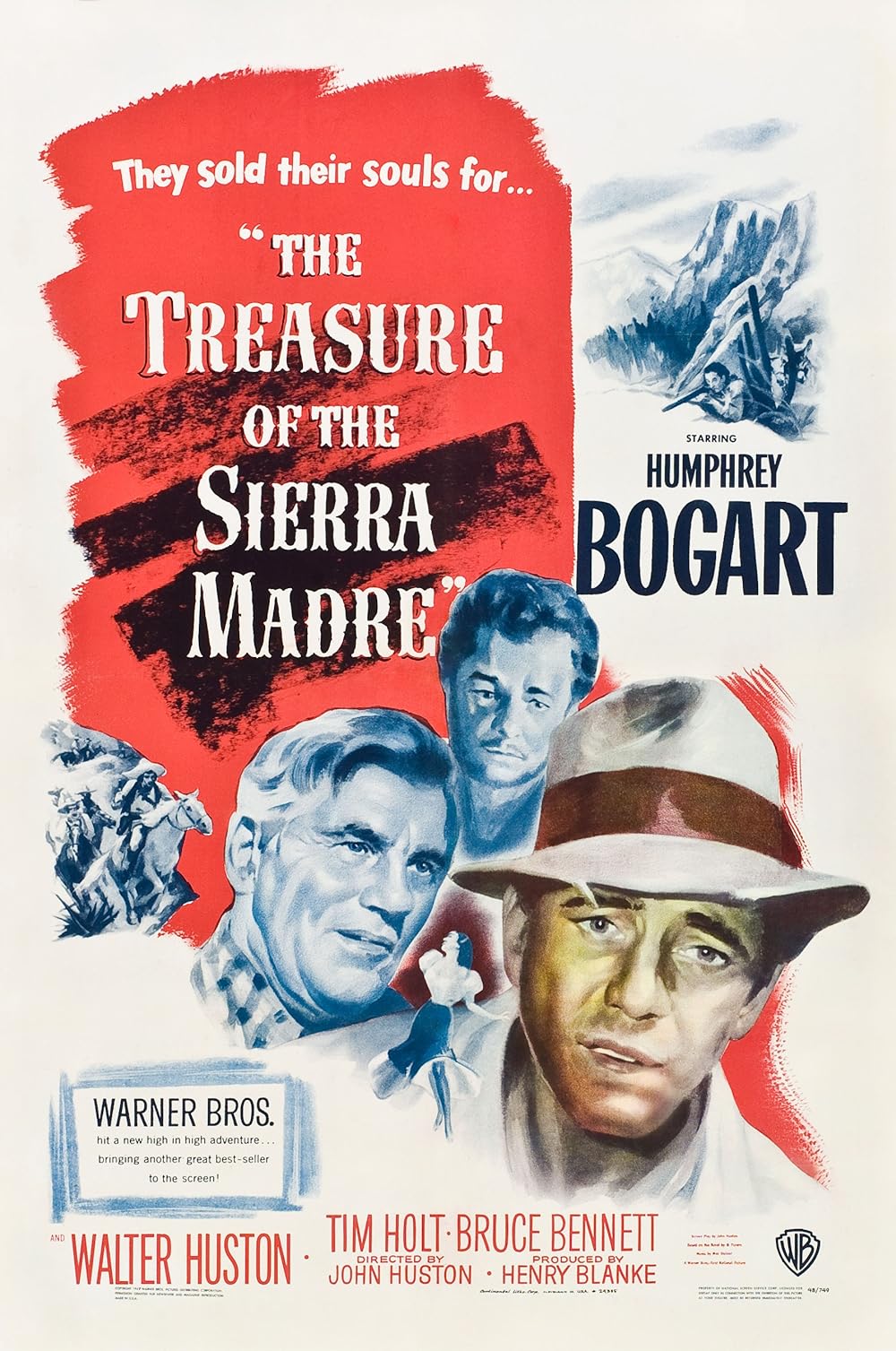The Treasure of the Sierra Madre (1948) – A Timeless Classic of Greed and Survival
Type: Movie
Country: United States
Genre: Adventure, Drama, Western
Release Date: January 16, 1948
Duration: 126 minutes
Director: John Huston
Production Companies: Warner Bros., Huston Productions
Cast: Humphrey Bogart, Walter Huston, Tim Holt, Bruce Bennett
Quick Review:
John Huston’s “The Treasure of the Sierra Madre” (1948) is a gripping adventure film that delves into the darker aspects of human nature through a thrilling tale of greed and survival. Featuring a standout performance by Humphrey Bogart and masterful direction by Huston, the film remains a compelling exploration of the corrupting influence of wealth and the struggle for survival in the unforgiving terrain of the Mexican wilderness.
Plot Summary:
The film follows the story of Fred C. Dobbs (Humphrey Bogart) and Bob Curtin (Tim Holt), two down-and-out Americans in Mexico, who meet veteran prospector Howard (Walter Huston). The trio embarks on a dangerous quest to find gold in the Sierra Madre mountains. Initially, the prospect of striking it rich fuels their determination, but as their search drags on and the gold is eventually found, greed begins to tear the group apart.
The harsh conditions of the desert and the growing mistrust among the men lead to escalating tensions. Paranoia sets in, resulting in betrayal and violence. The treasure, which initially seemed like a path to prosperity, becomes a curse that drives the characters to the brink of madness. In the end, their greed has disastrous consequences, illustrating the perils of avarice and the fragility of human integrity.
Characters and Performances:
- Humphrey Bogart (Fred C. Dobbs): Bogart delivers a career-defining performance as Fred C. Dobbs, a character whose transformation from hopeful prospector to paranoid madman is both compelling and unsettling. His portrayal captures the essence of human greed and desperation with remarkable intensity.
- Walter Huston (Howard): Walter Huston, who also happens to be the director’s father, provides a nuanced performance as the seasoned prospector Howard. His wisdom and experience contrast sharply with the naivety and greed of the other characters, adding depth to the film’s exploration of morality.
- Tim Holt (Bob Curtin): Holt’s portrayal of Bob Curtin serves as a foil to Dobbs’ descent into madness. His character’s struggle with greed and moral conflict is portrayed with authenticity, contributing to the film’s dramatic tension.
- Bruce Bennett (James Cody): Bennett plays James Cody, a fellow prospector whose appearance intensifies the existing tensions among the group. His role highlights the film’s theme of distrust and the destructive impact of greed.
Direction and Cinematography:
John Huston’s direction in “The Treasure of the Sierra Madre” is both taut and masterful. His ability to evoke the harsh realities of the desert environment and the psychological unraveling of the characters is a testament to his cinematic vision. The cinematography, handled by Ted McCord, effectively captures the rugged beauty of the Mexican landscape and the isolation of the characters. The stark visuals complement the film’s themes, enhancing its dramatic impact.
Music:
The film’s score, composed by Max Steiner, complements the narrative with its evocative and suspenseful themes. Steiner’s music underscores the tension and the emotional depth of the story, enhancing the viewer’s immersion into the film’s world. The score’s haunting melodies reflect the film’s themes of isolation, greed, and existential struggle.
Why It Endures:
“The Treasure of the Sierra Madre” endures as a classic due to its exploration of universal themes such as greed, trust, and survival. The film’s portrayal of the corrupting influence of wealth and the fragility of human morality resonates across generations. Its strong performances, particularly by Bogart and Huston, and its gripping narrative ensure its place in cinematic history. The film’s portrayal of the psychological effects of greed and its unflinching look at human nature continue to captivate and provoke thought.
In Conclusion:
John Huston’s “The Treasure of the Sierra Madre” (1948) stands as a timeless masterpiece of American cinema. Its powerful performances, compelling story, and exploration of profound themes make it a must-watch for any film enthusiast. The film’s ability to blend adventure with psychological drama, while offering a stark commentary on human nature, ensures its enduring legacy as one of the great classics of Hollywood’s Golden Age.


